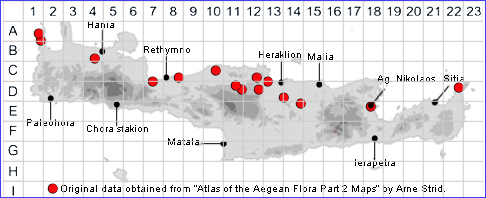
SPECIES DESCRIPTION
CREPIS DIOSCORIDIS
Family and Genus:- See- COMPOSITAE/Sect. ZACINTHA
Common Names:- None
Homotypic Synonyms:- Crepidium dioscoridis, Endoptera dioscoridis,
Gatyona dioscoridis, Pterotheca dioscoridis.
Meaning:- Crepis (Gr) A name used by Greek philosopher Theophrastus.
Dioscoridis (L) For Dioscorides Pedanios of Anazarbeus, Greek
military physician.
General description:- Annual or biennial.
Stems:-
1) 10-60 cm, usually branched.
Leaves:-
1) Glabrous or with sparse, eglandular hairs.
a) basal, 4-15 x 1-3 cm, lanceolate to oblanceolate, acute to obtuse, denticulate
to pinnatifid, with 6-8 wide triangular lateral segments.
b) Cauline, mostly sessile, lanceolate, acute or acuminate, denticulate,
amplexicaul with acute auricles.
Flowers:-
1) Involucre, 8-12 x 5-9 mm.
2) Bracts, linear to lanceolate acute, with glandular and sometimes eglandular
hairs, the outer 1/3-2/3 as long as the inner.
3) Florets, 11-18 mm.
4) Ligules, yellow, reddish-purple on the outer face.
5) Receptacle, with ciliate pits.
Fruit:-
1) Achenes, 3·5-5·5 mm, fusiform, curved, usually of 2 kinds:
a) marginal, greenish-yellow or whitish, with 2 lateral wings and usually 4- to 10-
ribbed.
b) inner, greenish-yellow or reddish-brown, with smooth or spinulose ribs; rarely
all achenes unwinged.
Key features:-
1) Receptacle, with ciliate pits.
2) Achenes, 3·5-5 x 0·5-2 mm, 4- to 10-ribbed. the marginal mostly broadly winged.
3) Ligules, yellow, usually with reddish stripe on outer face.
Habitat:- Dry pastures, olive groves, roadsides, stone cliffs. 0-600(-1000) m.
Distribution:- Fairly common in Peloponnisos, C & W mainland Greece and Ionian
Islands. - W Balkan Peninsula and Aegean region, just extending to SW Anatolia.
Somewhat limited distribution on Crete, mainly north of the C and C western
regions.
Flowering time:- Apr to mid-July.
Photos by:- Zacharias Angourakis
